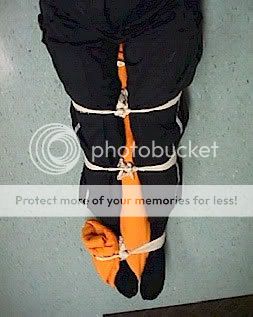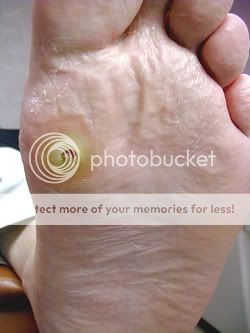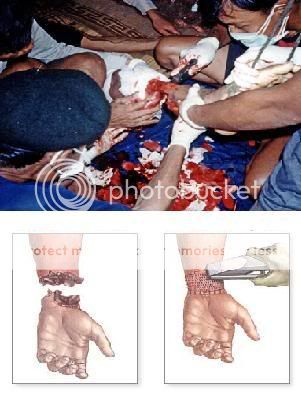A
cardiac arrest, also known as
cardiopulmonary arrest or
circulatory arrest, is the abrupt cessation of normal circulation of the
blood due to failure of the
heart to contract effectively during
systole.
Causes
Causes of cardiac arrest include:
Ventricular fibrillation —a rapid, irregular heart rhythm preventing any circulation of blood (most common cause of sudden cardiac arrest)
Ventricular tachycardia—a rapid, but regular heart rhythm that, if sustained, may turn into ventricular fibrillation
Dramatic slowing of heart rate due to failure of its pacemaker or severe heart block (interference with electrical conduction)
Respiratory arrest
Choking or drowning
Sudden loss of blood pressure
- Unknown causes
Risk Factors
A risk factor is something that increases your chance of getting a disease or condition.
Risk factors include:
Enlarged heart
Congenital heart disease
Improperly functioning heart valves
Conditions affecting the heart's electrical system
Severe metabolic imbalances
Adverse drug effects, such as from:
Lung conditions
Trauma to the chest
Extensive blood loss
Excessive overexertion in people with heart disorders
- Use of illicit substances (eg, cocaine)
Symptoms
Symptoms include:
Loss of consciousness
No breathing
- No pulse
Prior to cardiac arrest, some patients report the following symptoms or warning signs in the weeks before the event:
Chest pain
Weakness
Pounding in the chest
- Feeling faint
Diagnosis
The first person to respond to a cardiac arrest should check if the person is responsive. Shake the shoulders and ask, "Are you OK?" If there is no response, call 9-1-1. If there are other people around and you can perform
CPR (cardiopulmonary resuscitation), send someone to call 9-1-1 and turn your attention to the victim. Check if the person is breathing. Tilt the head back to open the airway. Put your cheek near the person's mouth and nose; look, listen, and feel for air movement. If no movement is detected, CPR should be started.
Treatment
Prompt treatment improves the chance of survival. The four steps in the cardiac chain of survival are:
Call For Help
Immediately call for emergency medical support. Call for emergency assistance as soon as you notice cardiac warning signs or suspect a cardiac arrest has occurred.
Start CPR
CPR helps keep blood and oxygen flowing to the heart and brain until other treatment can be given. The heart and brain are very susceptible to low oxygen levels. Permanent damage can occur, even with successful resuscitation. During CPR, the rescuer positions the head to open the airway, breathes air into the patient, and compresses the patient's chest.
Defibrillation
Once on the scene, emergency medical technicians or paramedics will assess the heart rhythm and determine whether the rhythm warrants defibrillation (eg, ventricular fibrillation or tachycardia). Defibrillation sends an electrical shock through the chest. The surge of electricity aims to stop the ineffective, irregular heart rhythm. This may allow the heart to resume a more normal electrical pattern. Automated external defibrillator's check the heart rhythm before instructing the rescuer to give the shock.
Advanced Medical Care
Paramedics at the scene and doctors at the hospital provide essential medical care and intensive monitoring. They will give drugs, insert a tube to maintain an open airway, and manage emergency care. Epinephrine is often given early to make the heart more receptive to electrical impulses and improve blood flow to the heart and brain. The patient will receive oxygen. Even if an effective heart rhythm is restored, low oxygen levels may cause serious complications, including damage to the heart, brain, and other vital organs. Doctors will attempt to find and correct the underlying cause of the cardiac arrest.
At the hospital, the doctor will ask about:
If the patient survives, the doctor will:
Assess the electrocardiograms performed by the emergency medical personnel
Perform a physical exam
Confirm a cardiac arrest has occurred
Look for the cause
Evaluate the effects of pre-hospital care
- Order additional blood and diagnostic tests to help determine the cause of the arrest
A telemetry machine will continually monitor the heart's electrical activity.
Prevention
Become aware of heart disease warning signs and promptly seek treatment for any that develop. If you do not have a heart condition, follow the rules of primary prevention of heart disease. If you have a heart condition or may be at high risk for one, ask your doctor about how to reduce your risk of sudden cardiac arrest. You might be a right candidate for certain medications that prevent heart arrhythmias or implantation of ICD device.
Also, if you are known to be at high risk, you may consider purchasing an automatic external defibrillator (AED) for home use. Discuss it with your doctor.
RESOURCES:
CANADIAN RESOURCES:
REFERENCES:
Braunwald E, Zipes DP, Libby P, et al. Heart Disease: A Textbook of Cardiovascular Medicine . 6th ed. Philadelphia, PA: WB Saunders Company; 2001.
Guidelines 2000 for Cardiopulmonary Resuscitation and Emergency Cardiovascular Care. Part 3: adult basic life support. The American Heart Association in collaboration with the International Liaison Committee on Resuscitation. Circulation . 2000; 102:I22
Heart Rhythm Society website. Available at: http://www.hrsonline.org/ . Accessed October 6, 2005.
Rakel RE, Bope ET. Conn's Current Therapy 2001 . 53rd ed. Philadelphia, PA: WB Saunders Company; 2001.
Rea TD, Eisenberg MS, Becker LJ, et al. Temporal trends in sudden cardiac arrest. Circulation . 2003; 107:2780.
Rosen P. Emergency Medicine: Concepts and Clinical Practice . 4th ed. St. Louis, MO: Mosby-Year Book Inc.; 1998.
Stevenson LW, Desai AS. Selecting patients for discussion of the ICD as primary prevention for sudden death in heart failure. J Card Fail . Aug 2006;12:407-412. Review.
All EBSCO Publishing proprietary, consumer health and medical information found on this site is
accredited by URAC. URAC's Health Web Site Accreditation Program requires compliance with 53 rigorous standards of quality and accountability, verified by independent audits.
To send comments or feedback to our Editorial Team regarding the content please email us at
healthlibrarysupport@ebscohost.com.























